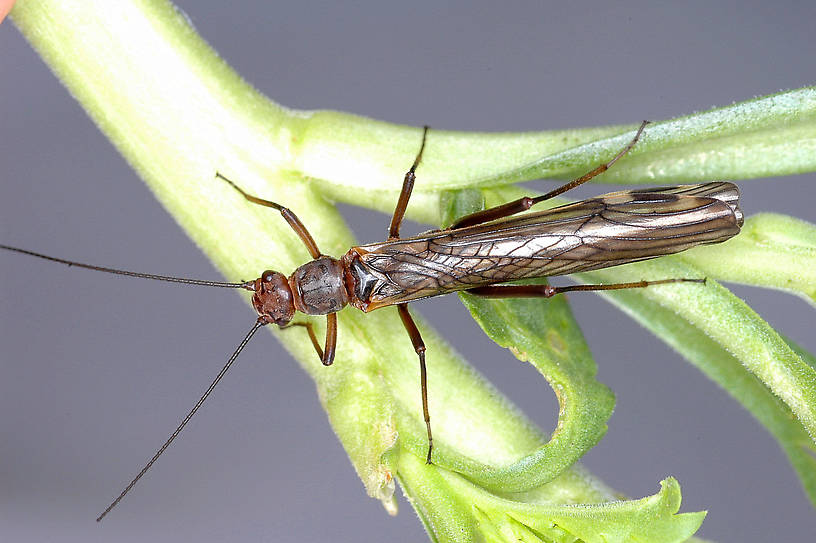
Salmonflies
Pteronarcys californica
The giant Salmonflies of the Western mountains are legendary for their proclivity to elicit consistent dry-fly action and ferocious strikes.


Stonefly Species Megaleuctra stigmata (Little Black Needleflies)
Species Range
Identification
Species ID from GBIFthe Global Biodiversity Information Facility
Source: The Genus Megaleuctra Neave (Plecoptera: Leuctridae) In North America
Diagnosis. The epiproct of Megaleuctra stigmata males is more similar to that of Megaleuctra complicata than to Megaleuctra kincaidi, the other western species. In Megaleuctra complicata this structure bears prominent, ventrally directed apical hooks (Figs. 3, 5, 8, 9) which gives the lateral aspect of the structure a meat hook-like appearance not found in Megaleuctra kincaidi (Figs. 36, 40), whereas in Megaleuctra stigmata the ventrally directed hooks are thinner and pointed downward at a sharper angle (Figs. 55, 61 - 63, 67). Males of Megaleuctra stigmata have a pair of stout dorsal lobes on tergum 9, which are broadly rounded and slant posteriorly (Figs. 54, 55, 61, 65, 67, 69), whereas in Megaleuctra complicata (Figs. 2, 3, 13, 15) and Megaleuctra kincaidi (Figs. 36, 38, 42, 48, 51), the paired lobes are thinner and terminate in pointed tips.
Physical description
Most physical descriptions on Troutnut are direct or slightly edited quotes from the original scientific sources describing or updating the species, although there may be errors in copying them to this website. Such descriptions aren't always definitive, because species often turn out to be more variable than the original describers observed. In some cases, only a single specimen was described! However, they are useful starting points.
Description from GBIFthe Global Biodiversity Information Facility
Source: The Genus Megaleuctra Neave (Plecoptera: Leuctridae) In North America
Male. Macropterous. Length of forewing 14 - 15 mm; body length 12 - 13 mm. General color brown. Wings hyaline, with dark stigma in costal space occupying more than half the costal space beyond the cord. Radial sector of forewing with 2 - 5 branches. Tergum 9 with a pair of large narrowly separated lobes, apically blunt, slanted posteriorly; darkly sclerotized forked structure at base, with long setae (Figs. 54, 55, 61); subgenital plate tongue-like, apex rounded, sometimes upturned (Figs. 55, 70); vesicle at base of sternum 9 long, and narrow. Tergum 10 with ventrobasal expansion darkly sclerotized, elongate, tip emarginate (Figs. 55, 61); epiproct broad at base dorsally, with large middorsal groove (Figs. 57, 65), forming rounded fork at apex, bearing small rounded processes laterally, ornamented with narrow leaf-like lobes, when expanded (Figs. 58, 62); epiproct stout and broad, rectangular dorsally, with large, paired, downward forked apical processes when in mid-length position (Figs, 65, 67), when expanded, broader at base, terminating in narrow apex, which surrounds apex of subanal probe (Figs. 54, 55, 57, 61). Subanal probe directed upward, fitting in middorsal groove of epiproct (Figs. 54, 57, 61, 62), tip expanded, with subapical notch in lateral view (Figs. 64, 68), upper lobe small, arched dorsally, with a pointed tube bearing apex, lower lobe large and broadly rounded (Figs. 60, 64, 66, 68). Cerci single segmented, elongate (Figs. 54, 55, 59, 70).
Female. Macropterous. Length of forewing 16 - 18 mm; body length 19 - 20 mm. Coloration similar to male. Radial sector of forewing with 2 - 5 branches, intercubital crossveins 15 - 20. Sternum 8 with subgenital plate extending past tip of abdomen 1.5 - 2.0 mm, narrowing gradually to tip, round in cross section (Fig. 56). Sternum 9 forming a long, narrow ovipositor (Figs. 71, 72).
Specimens of the Stonefly Species Megaleuctra stigmata
1 Adult

Start a Discussion of Megaleuctra stigmata
References
- Merritt R.W., Cummins, K.W., and Berg, M.B. 2019. An Introduction to the Aquatic Insects of North America (Fifth Edition). Kendall/Hunt Publishing Company.
Stonefly Species Megaleuctra stigmata (Little Black Needleflies)
Species Range
Common Names
Resources
- NatureServe
- Integrated Taxonomic Information System
- Global Biodiversity Information Facility
- Described by Banks, N. (1900) New genera and species of Nearctic Neuropteroid Insects. Transactions of the American Entomological Society 26, 239–259.

